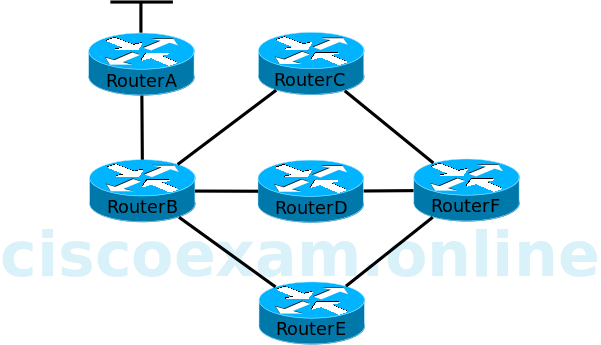
You administer the EIGRP network shown above. RouterB is configured to send only a summary route to RouterE. RouterC is configured as a stub router.
The link between RouterA and RouterB fails.
Which of the following routers will send a query to RouterF?
| A. |
only RouterC | |
| B. |
only RouterD | |
| C. |
only RouterE | |
| D. |
only RouterC and RouterD | |
| E. |
only RouterD and RouterE | |
| F. |
RouterC, RouterD, and RouterE |
Only RouterD will send a query to RouterF. Query packets are sent to find routes to a destination network. When a router loses the best route to a destination and does not have a feasible successor, it floods query packets to its neighbors. If a neighbor has a route to the destination network, it replies with the route. However, if a neighbor does not have a route to the destination network, it queries its neighbors, those neighbors query their neighbors, and so on. This process continues until either a router replies with the route or there are no routers left to query. The network cannot converge until all the replies have been received, which can cause a router to become stuck in active (SIA).
Limiting Enhanced Interior Gateway Routing Protocol (EIGRP) queries prevents queries from consuming bandwidth and processor resources and prevents routers from becoming SIA.
The eigrp stub command limits EIGRP queries by creating a stub router. Stub routers advertise only a specified set of routes and therefore typically need only a default route from a hub router. A hub router detects that a router is a stub router by examining the Type-Length-Value (TLV) field within EIGRP hello packets sent by the router. The hub router will specify in its neighbor table that the router is a stub router and will no longer send query packets to that stub router, thereby limiting how far EIGRP queries spread throughout a network. Because RouterC is configured as a stub router, RouterB will not send queries to RouterC, and RouterC will therefore not propagate those queries to RouterF. Although hub routers will not send queries to stub routers, stub routers can initiate queries of their own.
The ip summary address eigrp as number address mask command limits EIGRP queries by configuring route summarization. If a neighbor router has a summarized route but does not have the specific route to the destination network in the query, the neighbor router will reply that it does not have a route to the destination network and will not query its neighbors. Thus route summarization creates a query boundary that prevents queries from propagating throughout the network. In this scenario, RouterB is configured to send only a summary route to RouterE; therefore, RouterE will not send queries to RouterF.
RouterD is not configured as a stub router, and RouterB is not sending RouterD a summarized route. Therefore, when RouterB sends a query to RouterD, RouterD will send a query to RouterF.